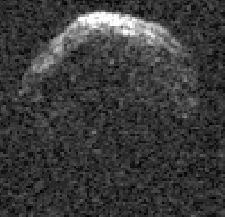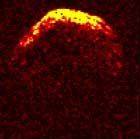(29075) 1950 DA
 Arecibo radio telescope radar image of 1950 DA on 4 March 2001, from a distance of 0.052 AU (22 lunar distances) | |
| Discovery | |
|---|---|
| Discovered by | Carl A. Wirtanen |
| Discovery date | February 22, 1950[1] |
| Designations | |
| 2000 YK66[2] | |
| Apollo | |
| Orbital characteristics[1] | |
| Epoch 2011-Aug-27 (JD 2455800.5) (Uncertainty=0)[1] | |
| Aphelion | 2.5618 AU (383.23 Gm) |
| Perihelion | 0.83529 AU (124.95 Gm) |
| 1.6985 AU (254.09 Gm) | |
| Eccentricity | 0.50823 |
| 808.59 d (2.21 yr) | |
Average orbital speed | 21.30 km/s |
| 246.03° | |
| Inclination | 12.175° |
| 356.74° | |
| 224.59° | |
| Physical characteristics | |
| Dimensions | 1.1–1.4 km 1.1 km (mean)[3] |
| Mass | >2×1012 kg[4] |
Mean density | >3.0 g/cm³ |
| 0.0884 d (2.1216 h)[1] | |
| Albedo | 0.2–0.25 |
Spectral type | E or M |
| 17.0[1] | |
(29075) 1950 DA is a near-Earth asteroid. It is notable for having the highest known probability of impacting Earth (between 0 and 0.33%).[3] It has the highest Palermo rating with a value of 0.17 for a possible collision in the year 2880.[3] For a brief period in late December 2004, asteroid 99942 Apophis held the record for Palermo scale values, with a value of 1.10.[5]
Discovery and name
1950 DA was first discovered on February 23, 1950, by Carl A. Wirtanen at Lick Observatory.[1] It was observed for seventeen days[6] and then lost because the short observation arc resulted in large uncertainties in Wirtanen's orbital solution. On 31 December 2000, it was recovered as 2000 YK66 and 2 hours later was recognized as 1950 DA.[6]
Observations
On March 5, 2001, 1950 DA made a close approach to the Earth of 0.0520726 AU (7,789,950 km; 4,840,450 mi).[7] It was studied by radar at the Goldstone and Arecibo observatories from March 3 to 7 2001.[6]

The studies showed that the asteroid has a mean diameter of 1.1–1.4 km (3,600-4,600 ft). Optical lightcurve analysis by Lenka Sarounova and Petr Pravec shows that its rotation period is 2.1216 ± 0.0001 hours. Due to its short rotation period and high radar albedo, 1950 DA is thought to be fairly dense (more than 3 g/cm³) and likely composed of nickel-iron.[8]
Possible Earth impact
That 1950 DA has one of the best-determined asteroid orbital solutions is due to a combination of:[6]
- an orbit moderately inclined (12 degrees)[1] to the ecliptic plane (reducing in-plane perturbations)
- high-precision radar astrometry that is more accurate than visual-wavelength measurements
- a 60-year observation arc[1]
- an uncertainty region controlled by resonance
The next radar opportunity for 1950 DA is in 2032.[6]
If 1950 DA continues on its present orbit, it will approach near to the Earth on March 16, 2880.[3] However, over the intervening time, its rotation will cause its orbit to slightly change as a result of the Yarkovsky effect. Available radar and optical data suggest two possible pole directions;[3] one trajectory misses the Earth by tens of millions of kilometers, while the other has an impact probability of roughly 1 in 300.[3]
The energy released by a collision with an object the size of 1950 DA would cause major effects on the climate and biosphere which would be devastating to human civilization. The discovery of the potential impact has heightened interest in asteroid deflection strategies.
See also
References
- ^ a b c d e f g h "JPL Small-Body Database Browser: 29075 (1950 DA)". Jet Propulsion Laboratory. 2010-10-04 last obs (arc=60.61 years). Retrieved 2011-11-19.
{{cite web}}: Check date values in:|date=(help) - ^ "MPEC 2001-A26 : 1950 DA = 2000 YK66". IAU Minor Planet Center. January 4, 2001. Retrieved November 19, 2011. (K00Y66K)
- ^ a b c d e f "Asteroid 1950 DA". NASA/JPL Near-Earth Object Program Office. Archived from the original on July 21, 2011. Retrieved October 14, 2011.
- ^ use a spherical radius of 0.55 km (0.34 mi); volume of a sphere * density of 3 g/cm3 yields a mass (m=d*v) of 2.09×1012 kg
- ^ Daniel Fischer (December 27, 2004). "2004 MN4 Earth Impact Risk Summary (computed on Dec 27, 2004)". The Cosmic Mirror. Retrieved November 4, 2011.
- ^ a b c d e Giorgini, J. D. (2002). "Asteroid 1950 DA's Encounter With Earth in 2880: Physical Limits of Collision Probability Prediction" (PDF). Science. 296 (5565): 132–136. Bibcode:2002Sci...296..132G. doi:10.1126/science.1068191. PMID 11935024.
{{cite journal}}: Unknown parameter|coauthors=ignored (|author=suggested) (help) - ^ "JPL Close-Approach Data: 29075 (1950 DA)". 2010-10-04 last obs (arc=60.61 years). Retrieved 2011-11-19.
{{cite web}}: Check date values in:|date=(help) - ^ 1950DA Planning on the NASA website (last accessed on October 7, 2007). (Broken)
External links
- Orbital simulation from JPL (Java) / Ephemeris


